Spot Guide Denmark: The best spots in Djursland - from standing water to waves
Manuel Vogel
· 13.10.2024
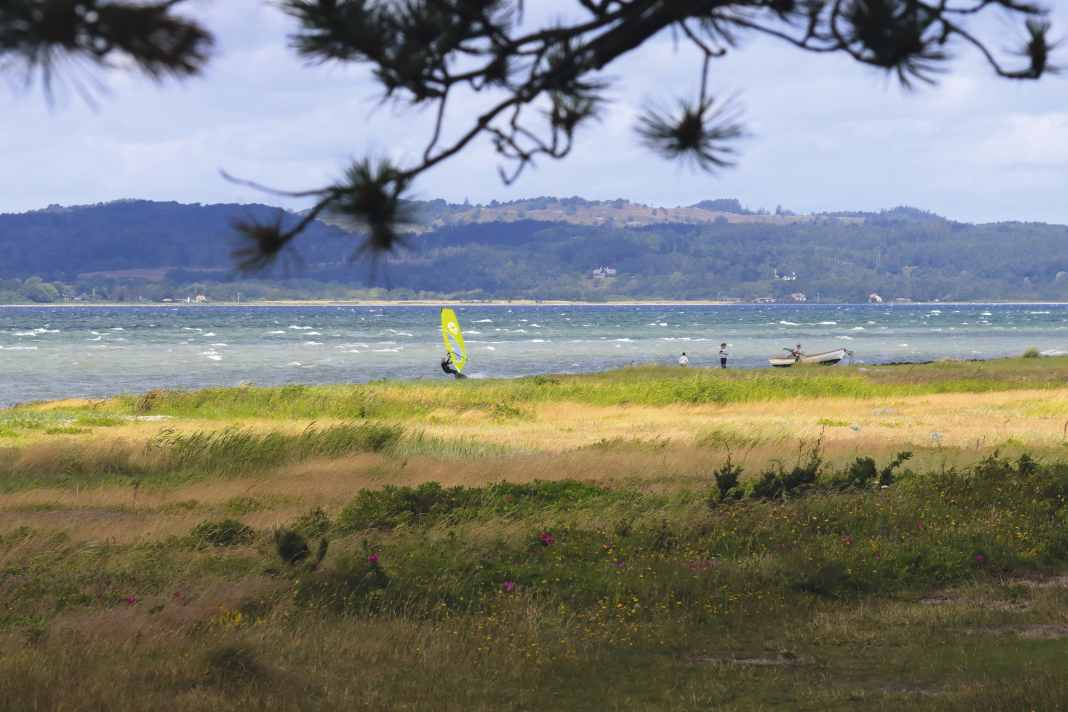





Those looking for surf usually end up in Cold Hawaii, while fans of standing water and shallow water flock to Ringkøbing Fjord - this is the normal distribution in Denmark. But only very few have been to the Danish peninsula of Djursland, which is actually unimaginable given the quality of the spots. The Djursland peninsula, located north-east of the Danish metropolis of Aarhus, can do both: flat water, surf - and everything in between!
Anyone approaching the peninsula from Aarhus will first be surprised by the hilly landscape, which is unusual for Denmark. The Mols Bjerge National Park stretches over 180 square kilometres with its extensive heathland and forest areas. The western side of Djursland, on the other hand, is flat and sandy, with bays cutting deep into the land and offering large standing areas - perfect for windsurfing. The heart of the surfing scene undoubtedly beats in Ebeltoft: the Ebeltoft Windsurf Club and a surf school have been located at the gates of the pretty old town with its half-timbered houses and cobbled streets since 2019, and even in winter you are rarely alone on the water here. Away from this main spot, Ahl, Strandsborg and Øer offer much quieter alternatives with wonderful sandy beaches and dunes.
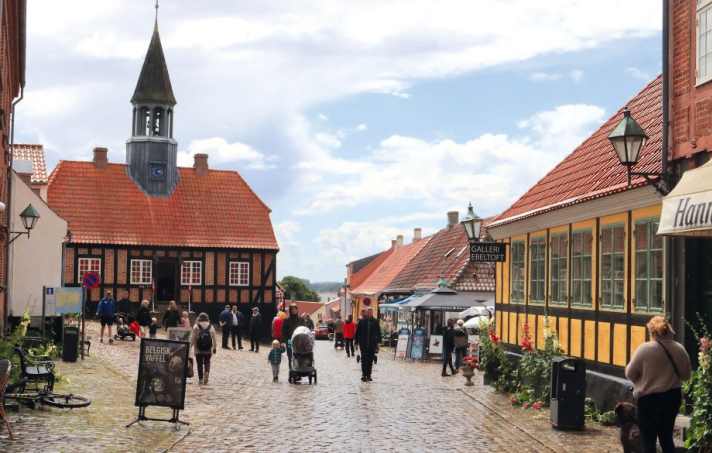
The best waves of the western Baltic Sea
The landscape is much rougher on the eastern side of Djursland, where the Baltic Sea gnaws at steep cliffs and considerable waves roll in when the wind blows from the east. With storms from the north and south-east, this is perhaps the most powerful breakers in the western Baltic Sea. And the best thing is: because the east side of Djursland is almost circular, there is basically a section of beach for every wind direction where the wind arrives sideshore. A session here is definitely an experience, and not just because of the beautiful waves: You can surf with a view of cliffs and beaches, with the old Fornæs lighthouse towering above you. The green hills of the national park stretch out behind it, and you usually only have to share the marvellous spots with a few other water sports enthusiasts.
Perhaps this spot guide will persuade you to leave the well-known spots behind and take a trip to Djursland. You won't regret it.
The best windsurfing spots in Djursland
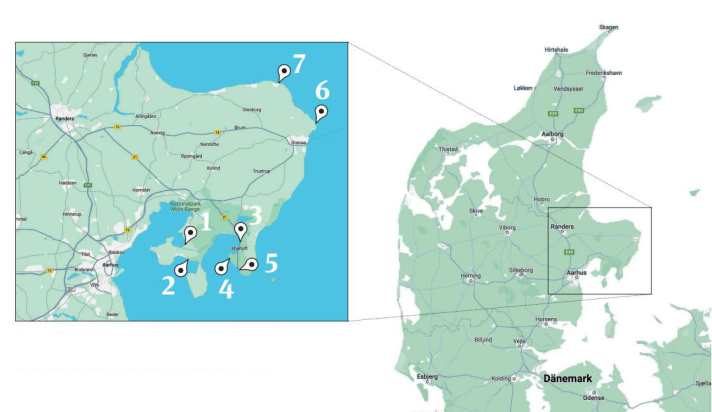
1st gag
56.2037, 10.4720
Knebel Vig is around 2.5 kilometres of inland water with only narrow access to the Baltic Sea. It is particularly worth going there when there is a strong south-westerly wind, which is usually a little weaker here than in Strands or Ebeltoft, for example. You can park directly at the harbour of the small village without height restrictions, and toilets are also available here. There is a largely sandy and shallow entrance to the left of the harbour. There is a gusty south-westerly wind from the left.
The spot is particularly great because the wind blows over a shallow sandbank, downwind of which there are excellent shallow water conditions that are ideal for freestyling. Here, you can ride at speed directly parallel to the sandbank in deep water and perform manoeuvres on mirror-smooth water. In cloudy weather, however, the sandbank is sometimes difficult to see as it is sometimes just below the surface of the water - so start by feeling your way carefully.
Further out, the bay offers more space and, depending on the wind strength and direction, small chops. You can also take to the water with foils. You can also surf quite safely in westerly to north-westerly winds, as you can get back into shallow water to the right of the harbour in an emergency.

2. strands
56.1804, 10.4698

A few kilometres south of Knebel is another beautiful and largely unknown spot, Strands. The long sandy bay stretches for around two kilometres and is exposed to wind directions from south-west to south-east. It is best to enter "Begtrupvig Strandvej" in the sat nav and then look for a suitable spot along the gravel road - there is no official car park and no public infrastructure. Depending on the wind direction, it blows relatively onshore either slightly from the left (south-east) or right (south-west) into the bay, which makes it very safe to surf here. The entrance is via a beautiful sandy beach, and the bottom is also largely sandy in the water. Depending on the wind strength, small waves can come in, which can easily break over the sandbank in front. Nevertheless, you can usually get out on the water here even without surfing experience, as the wave height remains manageable even in strong winds and the 1 metre mark is rarely exceeded. Outside the sandbank, there is typical Baltic Sea chop, which is good for small jumps. During longer south-westerly phases, seaweed can also collect in the bay in midsummer and autumn.

3 Ebeltoft
56.2184, 10.6704
The meeting point of the scene is Ebeltoft. The best place to park for the day is at Vibæk Strand, where parking is free and there are no height restrictions. There are also parking spaces a few hundred metres further south, at the surf club. A tip for campers is Ebeltoft Strand Camping - here you can park right next to the spot.
Winds from the south-west to west-north-west arrive in Ebeltoft at a nice constant speed and offer onshore conditions. The entrance is easy because it is shallow and partly sandy. There is a large standing area on the shore. In strong westerly to south-westerly winds, mini waves also break here, which you can use for your first jumps. Further out, there is plenty of space, moderate chop and sufficient water depth for foiling. There is a surf school on site, Blue Spirit, where you can take courses or hire equipment.
The historic town of just under 7,000 inhabitants is also worth a visit outside of surfing - in the beautiful old town you will find nice cafés, restaurants and, with the glass museum, the frigate Jylland and the small open-air museum in the town centre, a number of sights.

4. ahl
56.1732, 10.6444
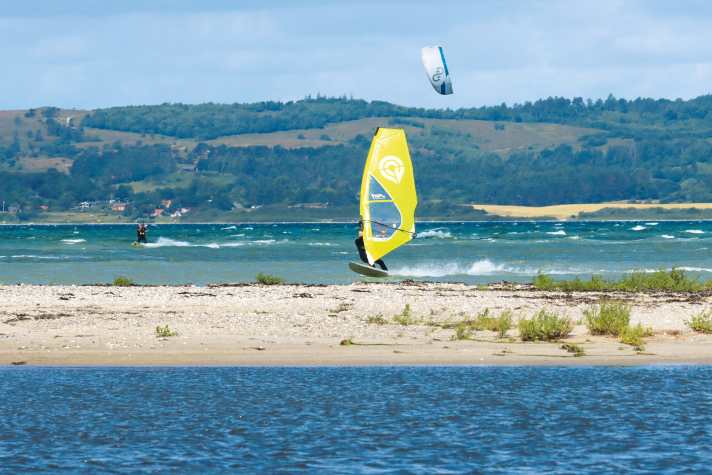
Ahl is a picturesque spot not far south-west of Ebeltoft. You can park in the pine forest behind the dunes. In front of the chic dune belt and sandy beach is a sandbank on which the small waves break gently in a south-westerly direction. Within the sandbank there are bump and jump conditions along the coast. If you surf from the entrance to the right/north towards the headland, you will reach a lagoon-like area after a few hundred metres. Partly shallow and with westerly to south-westerly winds, this is a great flat water area where you can surf in complete safety or hone your freestyle tricks. With long fins, you should first sound out the situation briefly, as the sandbanks shift again and again over time.
Word has got around within the water sports community that Ahl is one of the most beautiful spots on the Danish Baltic coast - windsurfers and kiters are equally at home here when the conditions are right.

5. Øer
56.1561, 10.6767
There is a wonderful lagoon area between the piers of the Øer harbour facilities, which works for intermediates as well as freestylers and freeriders and provides great shallow water conditions. Almost the entire bay is shallow, which is why there are always beginners on the water here - and kiters. You can park either at the mini car park at the north-eastern end (Øerkrogvejen) or by the kiters at the ferry pier.
The standing area is largely sandy, with a few stones. The ideal wind direction here ranges from north-west to west to south.

6. Grenaa/Fornæs
56.4557, 10.9497
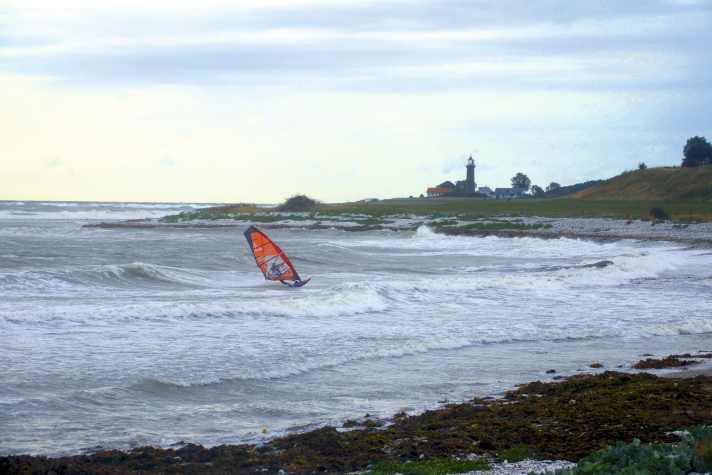
Wave fans will find what they are looking for near the small town of Grenaa, as Djursland sometimes shows its wild side around the chic Fornæs Fyr lighthouse. You can reach the water north of Fornæs Camping via the small Damsagervej. There is no official car park and no infrastructure, so you can park "wild" here. You can surf not far to the south. Fornæs is ideal with a south-easterly wind, which creates beautiful waves around the small cape, which you can use wonderfully for jumping and riding downwind with a sideonshore wind from the right. Experienced wave surfers also get their money's worth here if the wind is strong enough; depending on the wind direction and water level, there may be some shorebreak. At the left and right edge of the bay, the water is very shallow in places and it is easy to clip your fins here. The spot is at its best during northerly gales, when waves up to logo height form on the long way through the Kattegat with wind from the left - extremely rare, but also extremely good!

7th Gjerrild
56.5346, 10.8025
If the wind shifts from south-east to east, it is worth moving from Fornæs to Gjerrild Nordstrand, which is located around ten kilometres further north-west and has a more east-west orientation. You can park in a car park directly behind the dunes, from where you can reach the beautiful sandy beach after about 100 metres. The spot is ideal when the wind blows from the east, coming sideshore from the right and, depending on its strength, shovelling waves from knee to head-high onto the coast. These break over an offshore sandbank, which also offers good conditions for jumping and riding. However, the current is noticeable in strong winds. Tip: If the wind shifts even further to the east-northeast, it makes sense to move to Bønnerup N Strand, where you will find comparable conditions. Here you can park around the harbour, where there is also a camper van site (www.boennerup-lbh.dk/faciliteter/autocampere). Gjerrild and Bønnerup also work well in westerly north-westerly to north-westerly winds. The waves are then somewhat smaller, but still have the character of surf.

Spot Info Djursland
Journey
The Djursland peninsula can be reached from Hamburg via Kolding and Aarhus in just over four hours.
Living & Camping
It is no surprise that Djursland is also very well developed for tourism and offers a wide range of accommodation options. However, larger hotels or bed castles are not an issue here; instead, you usually stay in one of the nice Danish holiday homes that are scattered along the coast and can be booked online via the usual platforms (Novasol, Feriepartner etc.) - sometimes surprisingly cheap outside the holiday season. It's also worth taking a look at the website of the local provider ebeltoft-feriehusudlejning.com
Travelling by camper also makes sense, as there are several well-equipped campsites, some with direct access to the water. Here is a selection:
Ebeltoft
Grenaa
Fornæs
Gjerrild
More
Wild camping is generally prohibited in Denmark and punishable by hefty fines, but it is often tolerated outside the holiday season as long as you don't spread out and leave anything behind except footprints in the sand.
Wind, weather & waves
Unfortunately, there are no really meaningful wind statistics for this region - locals speak of 30 to 40 percent wind above twelve knots in midsummer and 50 to 60 percent in autumn and winter. This is probably no exaggeration, as Djursland is ventilated in all weather conditions due to its semi-circular shape. Although westerly winds are somewhat weaker than on the North Sea coast, wind directions from south to west to north-west are consistently good - but then it remains flat water to bump & jump conditions. The peninsula is particularly good when strong easterly winds settle in during spring and early summer. From south to east to north, there is always a beach on the east coast of the peninsula where the wind arrives at the right angle. Because the Baltic Sea off the coast is comparatively deep, this also creates considerable waves that thunder powerfully onto the beaches around Grenaa, where wave fans also get their money's worth. The biggest waves are created in strong winds from the south-east and especially from the north-east to north - sets up to logo height are then possible.
As everywhere in Denmark, the weather is not as stable as in southern climes - you can sweat here at 30 degrees in midsummer or throw on your rain jacket in 16 degrees and a south-westerly gale. Between June and October, with water temperatures of 18 to 20 degrees, a 4/3 or 5/3 long-sleeved wetsuit is sufficient; in the transition period, a bonnet and a warm wetsuit should also be in your luggage. Because there are also some stones or shells in the water at some spots, shoes are sometimes recommended.

Surf schools & shops
If you want to be on the water at the right spot in all weather conditions, you should be mobile on site - having your own equipment can be an advantage. At Blue Spirit in Ebeltoft, you can take courses and hire the latest equipment to take with you to other spots. There are around 30 sets available for beginners and ten sets from JP/NeilPryde for advanced riders. SUPs and wingfoil equipment can also be hired here, and there is also a small shop selling hardware and small parts if required. The centre is open from April to October; in winter, only the adjoining café and soon a beach sauna are open. Information at: www.bluespirit.dk There is another surf shop in Aarhus (www.surfline.dk).
Alternative programme
The hilly peninsula with the Mols Bjerge National Park is very scenic and invites you to go hiking or biking. While the east coast is rougher and sometimes even lined with high cliffs, the numerous bays in the south and west are often shallow and sandy. Aarhus, one of Denmark's most charming and trendiest cities, is also close by, where you can spend more than just a lazy day thanks to the wide range of cultural activities on offer. The small town of Ebeltoft is also worth a visit, with its historic old town and several sights, such as the small open-air museum or the frigate Jylland.
Good to know
Summertime is always seaweed season on the Baltic Sea, and Djursland is no exception. Corresponding Weed fins should therefore always be part of the basic equipment.

